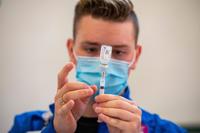Dr. Gurpreet Bambra, a Pulmonologist with 九游体育 Illinois Healthcare, who treats COVID patients at SIH Carbondale Memorial Hospital and SIH Herrin Hospital tells News 3 long term problems continue to persist, the so called post-COVID syndrome or long hauler syndrome.
"Typically we expect people to get better once their pneumonia is getting better," Bambra said. "About 10-percent of people do not get back to their baseline in about 3 weeks."
What's even more alarming is that many more are not getting back to normal.
"The DATA from the United States, is as much as 65-percent of people say they are not at their pre-COVID baseline (back to normal) even when they are free of the COVID," Bambra said.
And he's finding patients are coming in who had no symptoms of COVID-19 infection but are now experiencing the post viral infection.
"Anybody presenting with these symptoms in this COVID pandemic not all of those patients may have actually been diagnosed with COVID-19 infection," Bambra said. "Even if you had a mild infection and you were never tested, and you're presenting with these symptoms it is possible you were infected but you were never tested for that."
A patient鈥檚 age, prior health or severity of their COVID-19 case does not seem to matter.
"Long hauler syndrome is more common is young people who are not hospitalized," Bambra said. "We do not exactly know why people feel these symptoms. There are a few theories. It could be persistent viremia because of weak antibody response."
He said the other theories include a relapse of COVID-19, reinfection or subclinical inflammatory or immune reactions in the body.
"A virus present in the body even though it's not giving you clinical symptoms - like herpes is present forever," Bambra said. "We don't know the long term repercussions of COVID-19."
Some of Dr. Bambra's patients develop it six months after the disease was first identified.
We now know that the disease can cause heart damage, neurological issues that include stroke, and lung damage and clots that persist.
Chronic fatigue and respiratory issues are the most common symptoms, followed by a mix of other issues including what鈥檚 being called 鈥渂rain fog,鈥� body aches and muscle pain, abdominal issues and loss of smell and taste.
Dr. Bambra says people should not overlook the psychological effects as well and family members should be supportive that they may experience a post traumatic stress disorder from the experience of COVID-19.
"It is a real phenomenon which is happening to post-COVID patients," Bambra said.
To know when to see a doctor for further care Dr. Bambra said it starts with monitoring the oxygen level in the blood.
"Patients should have a pulse oximeter at home," Dr. Bambra said. "They should be trained on how to monitor their own oxygen saturation and if they are able to walk around with oxygen saturation of more than 94-percent for six minutes that is reassuring that this is unlikely something serious."
But if it's less it may be time to call a doctor.
"If symptoms persist or worsen they need to be discussed with their doctor," Bambra said.














